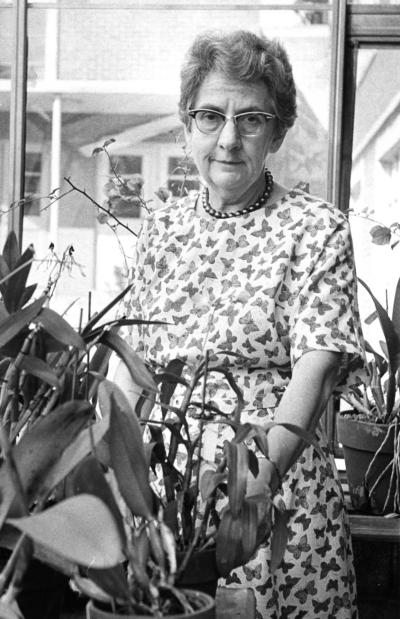Herbarium
The Herbarium of the University of Tennessee at Chattanooga - UCHT
Curators
Molecular systematics; floristics; exotic invasive plant species
Chestnut Breeding; chestnut blight; Mycology
The Mission
The University of Tennessee Herbarium (UCHT) will strive to support basic and applied research in the plant sciences, particularly systematics and taxonomy, environmental science, plant geography, and studies of species of special concern. It will continue to grow as an important botanical resource for southeast Tennessee, northwest Georgia, northeast Alabama, and broader scientific community. We will strive to lead Tennessee in digitizing Tennessee's herbarium collections and making the data available to the public.

Prof. McGilliard
The Collection
The collection of plants at UCHT is comprised of approximately 45,000 specimens of macroalgae, seedless and seed-bearing plant specimens primarily from southeastern Tennessee, northwest Georgia, and northeast Alabama. However, UCHT houses specimens from all across North America, Africa, and Asia.
The UTC Herbarium, UCHT, is the oldest herbarium in Tennessee and was established in 1886 (Index Herbariorum). UCHT is the third largest herbarium in TN, behind TENN and APSC (Austin Peay State University herbarium).
As a collection, UCHT gained a solid foundation with early, important, southeast Tennessee collections by Eleanor McGilliard and her students from the 1920s-1960s. During that time, UCHT grew to about 3000 specimens. Because McGilliard was an excellent botanist, the specimens collected at that time were scientific and historic; e.g., she collected Hart’s-tongue fern, one of the rarest ferns in the U.S., in Tennessee from “the only southern station” and before the population was corrupted in 1935 with spores from a population from Owen Sound, Ontario. She and her students collected the first specimen of Clematis fremontii, Ranunculaceae, from Tennessee, although she misidentified it at the time and later Horn and Shaw determined it to be C. fremontii and a new species for Tennessee and only one of two populations east of the Mississippi River. Following McGilliard, from 1965-1971, several UTC faculty with tangential interest in plants contributed several hundred specimens from the Southeast Coastal Plain from Louisiana and Mississippi to Florida and the Carolinas.
The next long term curator of UCHT was Gene Van Horn, a plant ecologist, who was hired in 1971 (-2005). In 1974 he estimated UCHT consisted of 5400 specimens. Van Horn made considerable collections from southeast TN and northwest Georgia. With the addition of the M.S. graduate program in the mid-1990s, ~2000 higher-quality collections were added to UCHT under Van Horn’s supervision and through the collection effort of John Beck. In 2005, when PI Shaw was hired, UCHT was ~7500 specimens in nine cabinets. Under his curation, UCHT has grown to 57 cabinets and ~45,000 specimens.
UCHT has grown in specimen number through Shaw’s personal collections from across the U.S., six regional floristic M.S. projects in Tennessee and Georgia (e.g., Huskins and Shaw, 2010; Blyveis and Shaw, 2012; Prater and Shaw, submitted), five undergraduate floristic projects, exchange programs with TENN, APSC, BALT, USMS, VSC, NCU, and GA, and a trade of 5000 Robert Kral duplicates from BRIT in exchange for work at BRIT.

Dr. Van Horn
Bringing the Herbarium into the 21st Century
UCHT is the lead institution for the Tennessee effort to digitize our state’s herbarium collections and make their data available to researchers, educators, conservationists, policy makers, and hobbyists. We’re working toward the future goal of linking to all of the other herbaria in the southeast in the Southeastern Regional Network of Expertise and Collections, or SERNEC. Tennessee is home to approximately 900,000 specimens in 13 separate herbaria and UTC, along with Middle Tennessee State University, and Austin Peay State University are leading this work. Press releases from our partners and collaborators at UT Martin and Tennessee Technological University highlight aspects of our collaborative.
If you want to know more, or how you can help, please contact Joey Shaw, Curator of the UTC Herbarium.